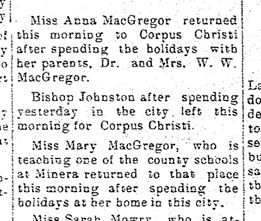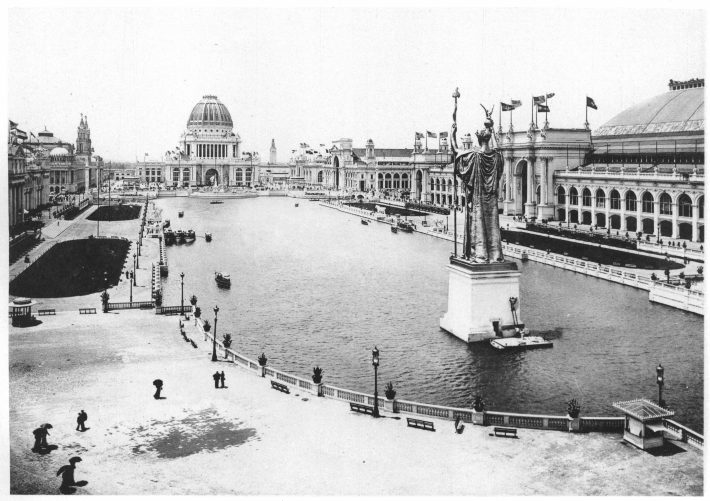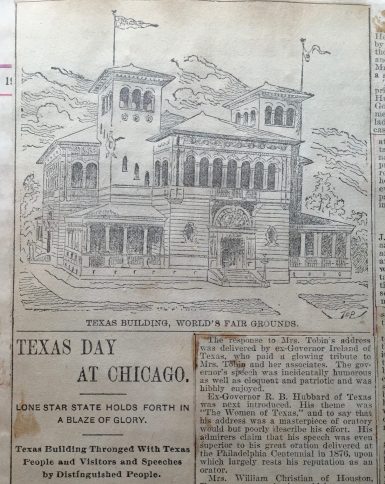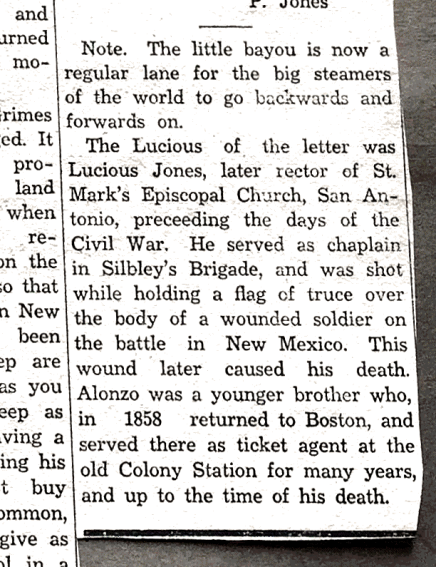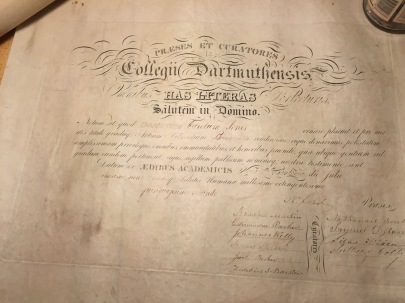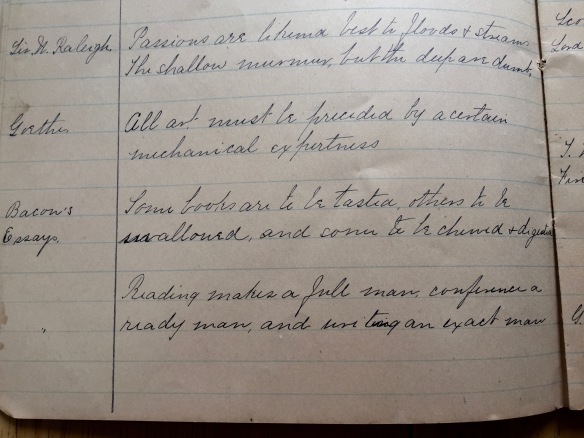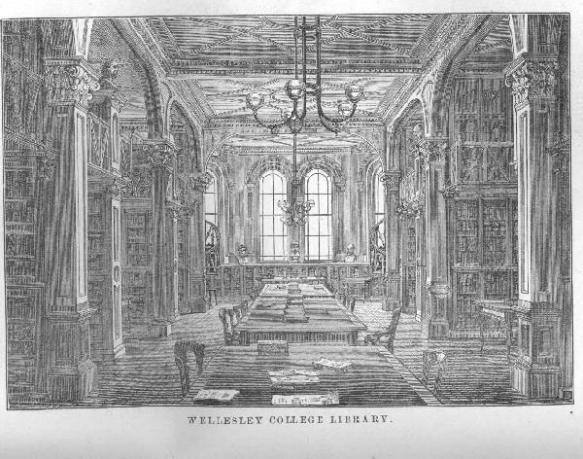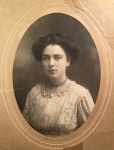
Anna MacGregor, Helen MacGregor, and Mary MacGregor (second, third, and fifth from left), in front of Minera, Texas post office, early 1900s.
So you remember this photo from this entry a couple months back on the MacGregor sisters, right? These were my great-grandmother Mary and her sisters; Mary would eventually marry into the Jameson family. The sisters and their parents lived in Laredo, Texas, on the Mexico border. And, as I figured out from studying the photo above closely, a couple of the sisters sometimes visited a nearby coal mining town called Minera,Texas. When you click on the photo and view it at full size you can just make out the name of the town on the sign to the right.
I didn’t know why the girls were in Minera. In the photo albums I have, which I believe belonged to Anna and Mary, there are several photos taken there. Here’s another one:

Anna MacGregor, second from left, Minera, Texas. Others in photo not known, though the man to right of Anna may have come from nearby Fort McIntosh. (He also looks like he could be the young man in the previous photo)
I had the vague notion that the girls and their friends went there on occasional jaunts, based on pictures like the one below, where the place seems like a playground to them.
But I’ve found enough bits and pieces to make me wonder if one or both of the girls lived at Minera. Or at least stayed there sometimes, in order to teach school.
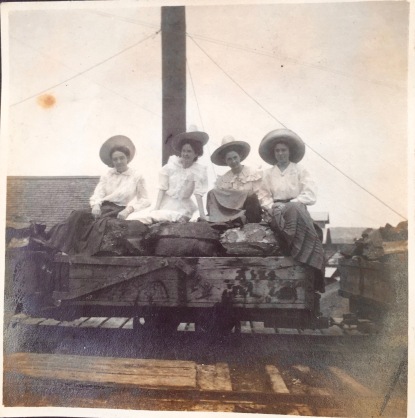
Anna at far left, Mary far right.
The key piece of information comes from Helen, the third oldest of the MacGregor sisters (after Anna and Mary). Helen’s papers include a brief autobiographical account of her childhood and teaching career, in which she mentions spending four years after college teaching at the school at Dolores, another small mining town outside of Laredo.
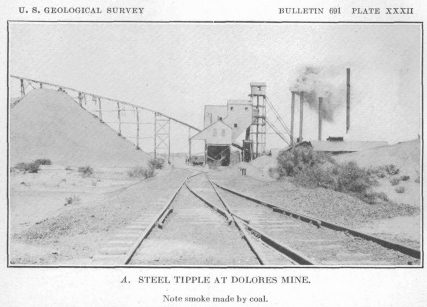
Dolores Mine (image from Google Books)
In the 1910 census, all the sisters were living at home: Helen was 17 and still a student, but Mary, 20, and Anna, 22, were listed as public school teachers. Going by the clothing, the photos don’t appear to be taken later than 1910, and could have been a few years earlier. If Helen taught school at Dolores during her early twenties, isn’t it possible that one or both of her sisters did the same thing, a few years earlier, in Minera?
I went back to those old photo albums and found these:
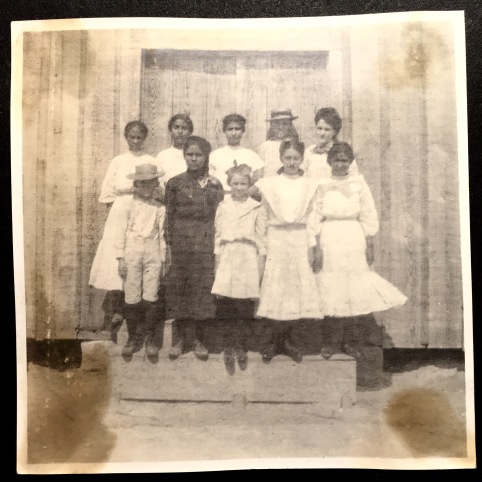

Those look like students all right!
I forgot these were in one of the albums. I hadn’t photographed every picture in there—I’d mostly been looking at the snapshots of the sisters, taking cameraphone pictures of them so I could get a closer look and make out who was who. But that meant I’d stopped looking in the albums and was missing the wider context.
In the same album pages are more pictures of what could be Minera:

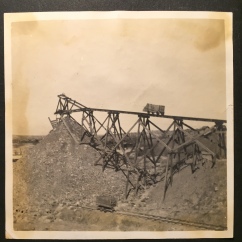

Minera no longer exists. A 1940s article called The Life and Times of Minera, Texas, apparently written by a descendant of one of the mine supervisors, seems to be the most detailed account of the place. It says that Minera was 25 miles from Laredo at the end of a branch railroad line, and that the trip took the better part of a day (in 1895 at least). The article mentions that the superintendent and his wife lived in a “comfortable, roomy stone house” with a broad, flat roof, and that the wife’s presence “made it agreeable for two young ladies to come out from Laredo and conduct a school for the children of the miners.”
A number of the photos that appear alongside the mine pictures show a stone house with a flat roof. Could it be the superintendent’s house? It doesn’t seem to be the MacGregor place (which had a shadier yard and was more clearly in town, with the Laredo post office building visible across the street.)
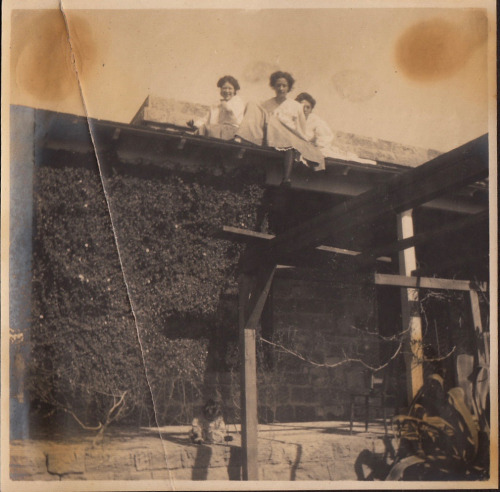
Anna (I think, at far right) and friends on roof of mystery building. Fits description of Minera supervisor’s house, the roof of which was said to have been used as an observation deck to see across to the Mexico side of the Rio Grande.
Anna shows up most often in the photos; not sure if that means they were her pictures, perhaps recording her experience at the mine. My theory is that one or both of the sisters and possibly other young women lived at the supervisor’s house during the school year as guest-boarders under the watch of the supervisor’s wife. Helen, on the other hand, describes the Dolores mine as being near her home—it was a shorter distance, closer to ten miles—and by the time she would have been old enough to teach (1911 or so?) the trains were likely faster. Another possibility is that the sisters frequently visited a friend who taught at Minera, but the number of photos—and the fact that Anna and Mary were listed on the census as teachers at around the same time—makes me think otherwise.
Anna, who would later travel to in the Philippines and have her wedding there, strikes me as the adventurous one, the sort who would get a kick out of teaching in a mining camp. According to The Life and Times of Minera, in the early days (before 1900), dances were held in the schoolhouse every Saturday night, “which generally ended in a tequila-inspired brawl during early dawn. On Sundays they held cock-fights, and every payday nearly everybody got drunk at the cantina.” Nice! In the later years, though, the residents were ordered “to refrain from sticking knives into each other at Saturday night bailies in the schoolhouse.” Oh well, Anna and Mary look like they could make their own fun.
Minera was abandoned around 1915 after flooding in the mine shafts forced the mining operations to move further inland from the river. It’s listed as a ghost town in some guides. Somehow it still shows up on Google maps. Dolores isn’t marked, but the maps I found show it was in the area in the right-hand corner of the page, beneath Highway 255.

The Life and Times ends with a last look from 1945:
“…the old stone walls of the superintendent’s house furnish a shelter to countless bats … The well-preserved cement floors are barely discernible beneath the blown dry earth that is gradually covering them over, and in another generation there probably will be no witness remaining who remembers the gayety and excitement that once was Minera, Texas…”
UPDATE: A number of newspaper items confirm that indeed Anna and Mary taught school at Minera.
 September 1908:
September 1908: November 1908: Little ten-year-old sister Kathryn comes up to visit! (Bonus: Mrs. Roy was the wife of the mine superintendent.)
November 1908: Little ten-year-old sister Kathryn comes up to visit! (Bonus: Mrs. Roy was the wife of the mine superintendent.)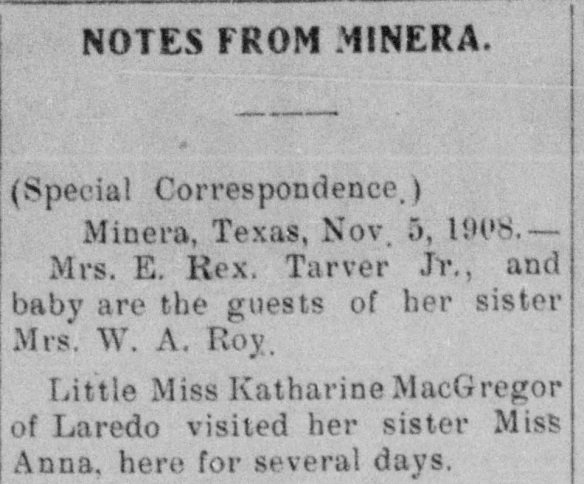 Mary had the teaching gig by September 1910, when she was around twenty. Obviously she survived the ordeal described below. (Homesickness maybe?)
Mary had the teaching gig by September 1910, when she was around twenty. Obviously she survived the ordeal described below. (Homesickness maybe?) February 1911: Guess they had a long holiday break. Interesting that Anna was living in Corpus Christi at this point. She might have been staying with the cousins and great-aunts/uncles who might have still been living up there. Was she teaching school there, too?
February 1911: Guess they had a long holiday break. Interesting that Anna was living in Corpus Christi at this point. She might have been staying with the cousins and great-aunts/uncles who might have still been living up there. Was she teaching school there, too?